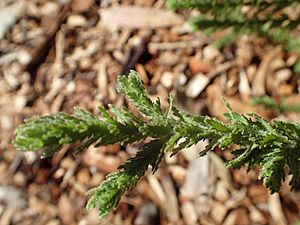Dalwallinu eremophila facts for kids
Quick facts for kids Dalwallinu eremophila |
|
|---|---|
 |
|
| Foliage of E. pinnatifida in Kings Park, Perth | |
| Conservation status | |
| Scientific classification | |
| Genus: |
Eremophila (plant)
|
| Species: |
pinnatifida
|
The Eremophila pinnatifida, also known as the Dalwallinu eremophila, is a special flowering plant. It belongs to the figwort family, called Scrophulariaceae. This plant is found only in Western Australia, which means it is endemic there.
It is a rounded shrub that spreads out. Its leaves have a nice smell and are deeply divided, almost like a fern. The flowers are a pretty pale purple color. Inside, they are white with purple spots. This plant is quite rare. You can only find it in a few places near Perth.
Contents
What it Looks Like
The Dalwallinu eremophila is an upright, rounded shrub that smells good. It usually grows to be about 0.6 to 1 meter (2 to 3 feet) tall. Its branches are mostly hidden by its many leaves. These branches are covered in tiny hairs, some of which are sticky and yellow.
The leaves grow in groups of three, like spokes on a wheel. They overlap each other. Each leaf is shaped like an egg and is deeply divided. They are about 5 to 9.5 millimeters (0.2 to 0.4 inches) long and 2.5 to 4.5 millimeters (0.1 to 0.2 inches) wide. The leaves feel sticky because they have a natural substance called resin on them. They are also covered in tiny sticky hairs. Longer white hairs are mostly found on the top surface of the leaves.
The flowers grow one by one where the leaves meet the stem. They do not have a stalk. Each flower has 5 green, thin, hairy parts called sepals. These sepals are about 5 to 8 millimeters (0.2 to 0.3 inches) long. The petals are 18 to 25 millimeters (0.7 to 1 inch) long. They are joined together at the bottom to form a tube shape.
The outside of the flower tube is pale to deep purple. The inside is white with pale purple spots. The outside of the tube and its tips are hairy. But the inside of the petal tips is smooth. The inside of the tube is full of long, soft hairs. There are 4 stamens (the parts that make pollen) inside the petal tube. They are completely hidden.
This plant flowers from August to January. After the flowers, it grows fruits. These fruits are dry, woody, and oval-shaped with a pointed end. They are about 4 millimeters (0.2 inches) long and have a hairy covering.
Plant Name and History
This plant was first officially described in 2007 by a scientist named Robert Chinnock. He wrote about it in a book called Eremophila and Allied Genera: A Monograph of the Plant Family Myoporaceae.
The second part of its scientific name, pinnatifida, comes from a Latin word. It means "lobed in a pinnate manner." This describes how the leaves are deeply cut, almost three-quarters of the way to the middle vein.
Where it Lives
The Dalwallinu eremophila grows in loamy soil. Loamy soil is a mix of sand, silt, and clay. It lives in tall, open Eucalyptus woodland areas. You can find it between the towns of Dalwallinu and Wongan Hills in a natural area called the Avon Wheatbelt.
Protecting This Plant
The Eremophila pinnatifida is a very rare plant. It is listed as "Threatened Flora" by the Department of Environment and Conservation (Western Australia). This means it is a plant that needs special protection. A plan has been made to help this plant recover and survive.
Growing it in Gardens
This plant grows quickly and has attractive leaves that look like ferns. It produces many flowers in spring and early summer, making a beautiful display. Many people grow it in gardens in eastern Australia. However, sometimes it does not live very long there.
You can easily grow new plants from cuttings (small pieces of the plant). It can grow in most types of soil, even clay. But it likes a sunny spot the best. This plant can handle long dry periods and also frost.


